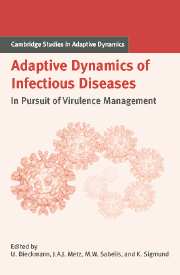Book contents
- Frontmatter
- Contents
- Contributing Authors
- List of Boxes
- Notational Standards
- 1 Introduction
- A Setting the Stage
- B Host Population Structure
- C Within-Host Interactions
- Introduction to Part C
- 9 Super- and Coinfection: The Two Extremes
- 10 Super- and Coinfection: Filling the Range
- 11 Multiple Infection and Its Consequences for Virulence Management
- 12 Kin-selection Models as Evolutionary Explanations of Malaria
- D Pathogen–Host Coevolution
- E Multilevel Selection
- F Vaccines and Drugs
- G Perspectives for Virulence Management
- References
- Index
- International Institute for Applied Systems Analysis
9 - Super- and Coinfection: The Two Extremes
Published online by Cambridge University Press: 15 January 2010
- Frontmatter
- Contents
- Contributing Authors
- List of Boxes
- Notational Standards
- 1 Introduction
- A Setting the Stage
- B Host Population Structure
- C Within-Host Interactions
- Introduction to Part C
- 9 Super- and Coinfection: The Two Extremes
- 10 Super- and Coinfection: Filling the Range
- 11 Multiple Infection and Its Consequences for Virulence Management
- 12 Kin-selection Models as Evolutionary Explanations of Malaria
- D Pathogen–Host Coevolution
- E Multilevel Selection
- F Vaccines and Drugs
- G Perspectives for Virulence Management
- References
- Index
- International Institute for Applied Systems Analysis
Summary
Introduction
As is well known, the “conventional wisdom” that successful parasites have to become benign is not based on exact evolutionary analysis. Rather than minimizing virulence, selection works to maximize a parasite's reproduction ratio (see Box 9.1). If the rate of transmission is linked to virulence (defined here as increased mortality due to infection), then selection may in some circumstances lead to intermediate levels of virulence, or even to ever-increasing virulence (see Anderson and May 1991; Diekmann et al. 1990, and the references cited there).
A variety of mathematical models has been developed to explore theoretical aspects of the evolution of virulence (see, for instance, Chapters 2, 3, 11, and 16). Most of these models exclude the possibility that an already infected host can be infected by another parasite strain. They assume that infection by a given strain entails immunity against competing strains. However, many pathogens allow for multiple infections, as shown in Chapters 6, 12, and 25. The (by now classic) results on optimization of the basic reproduction ratio cannot be applied in these cases.
The mathematical modeling of multiple infections is of recent origin, and currently booming. Levin and Pimentel (1981) and Levin (1983a, 1983b) analyzed two-strain models in which the more virulent strain can take over a host infected by the less virulent strain. They found conditions for coexistence between the two strains. Bremermann and Pickering (1983) looked at competition between parasite strains within a host, and concluded that selection always favors the most virulent strain.
- Type
- Chapter
- Information
- Adaptive Dynamics of Infectious DiseasesIn Pursuit of Virulence Management, pp. 124 - 137Publisher: Cambridge University PressPrint publication year: 2002
- 10
- Cited by

